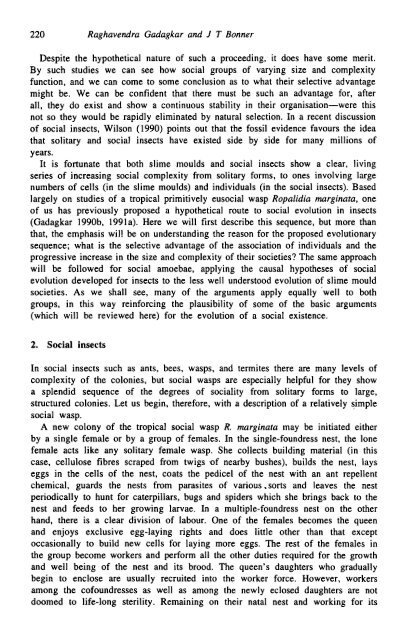Social insects and social amoebae. - Centre for Ecological Sciences
Social insects and social amoebae. - Centre for Ecological Sciences
Social insects and social amoebae. - Centre for Ecological Sciences
Create successful ePaper yourself
Turn your PDF publications into a flip-book with our unique Google optimized e-Paper software.
220 Raghavendra Gadagkar <strong>and</strong> J T BonnerDespite the hypothetical nature of such a proceeding, it does have some merit.By such studies we can see how <strong>social</strong> groups of varying size <strong>and</strong> complexityfunction, <strong>and</strong> we can come to some conclusion as to what their selective advantagemight be. We can be confident tnat there must be such an advantage <strong>for</strong>, afterall, they do exist <strong>and</strong> show a continuous stability in their organisation-were thisnot so they would be rapidly eliminated by natural selection. In a recent discussionof <strong>social</strong> <strong>insects</strong>, Wilson (1990) points out that the fossil evidence favours the ideathat solitary <strong>and</strong> <strong>social</strong> <strong>insects</strong> have existed side by side <strong>for</strong> many millions ofyears.It is <strong>for</strong>tunate that both slime moulds <strong>and</strong> <strong>social</strong> <strong>insects</strong> show a clear, livingseries of increasing <strong>social</strong> complexity from solitary <strong>for</strong>ms, to ones involving largenumbers of cells (in the slime moulds) <strong>and</strong> individuals (in the <strong>social</strong> <strong>insects</strong>). Basedlargely on studies of a tropical primitively eu<strong>social</strong> wasp Ropalidia marginata, oneof us has previously proposed a hypothetical route to <strong>social</strong> evolution in <strong>insects</strong>(Gadagkar 1990b, 1991a). Here we will first describe this sequence, but more thanthat, the emphasis will be on underst<strong>and</strong>ing the reason <strong>for</strong> the proposed evolutionarysequence; what is the selective advantage of the association of individuals <strong>and</strong> theprogressive increase in the size <strong>and</strong> complexity of their societies? The same approachwill be followed <strong>for</strong> <strong>social</strong> <strong>amoebae</strong>, applying the causal hypotheses of <strong>social</strong>evolution developed <strong>for</strong> <strong>insects</strong> to the less well understood evolution of slime mouldsocieties. As we shall see, many of the arguments apply equally 'well to bothgroups, in this way rein<strong>for</strong>cing the plausibility of some of the basic arguments(which will be reviewed here) <strong>for</strong> the evolution of a <strong>social</strong> existence.2. <strong>Social</strong> <strong>insects</strong>In <strong>social</strong> <strong>insects</strong> such as ants, bees, wasps, <strong>and</strong> termites there are many levels ofcomplexity of the colonies, but <strong>social</strong> wasps are especially helpful <strong>for</strong> they showa splendid sequence of the degrees of <strong>social</strong>ity from solitary <strong>for</strong>ms to large,.structured colonies. Let us begin, there<strong>for</strong>e, with a description of a relatively simple<strong>social</strong> wasp.A new colony of the tropical <strong>social</strong> wasp R. marginata may be initiated eitherby a single female or by a group of females. In the single-foundress nest, the lonefemale acts like any solitary female wasp. She collects building material (in thiscase, cellulose fibres scraped from twigs {)f nearby bushes), builds the nest, layseggs in the cells of the nest, coats the pedicel of the nest with an ant repellentchemical, guards the nests from parasites of various. sorts <strong>and</strong> leaves the nestperiodically to hunt <strong>for</strong> caterpillars, bugs <strong>and</strong> spiders which she brings back to thenest <strong>and</strong> feeds to her growing larvae. In a multiple-foundress nest on the otherh<strong>and</strong>, there is a clear division of labour. One of the females becomes the queen<strong>and</strong> enjoys exclusive egg-laying rights <strong>and</strong> does little other than that exceptoccasionally to build new cells <strong>for</strong> laying more eggs. The rest of the females inthe group become workers <strong>and</strong> per<strong>for</strong>m all the other duties required <strong>for</strong> the growth<strong>and</strong> well being of the nest <strong>and</strong> its brood. The queen's daughters who graduallybegin to enclose are usually recruited into the worker <strong>for</strong>ce. However, workersamong the cofoundresses as well as among the newly eclosed daughters are notdoomed to life-long sterility. Remaining on their natal nest <strong>and</strong> working <strong>for</strong> its
















